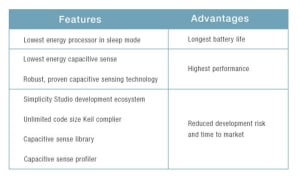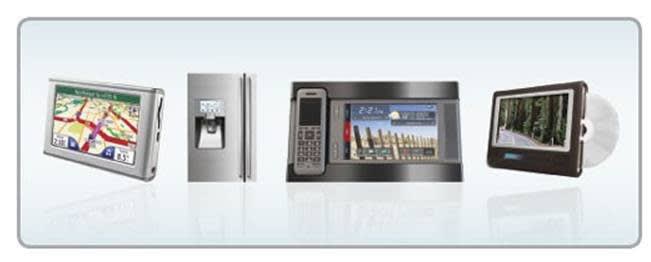Want to know the secret to tackling three human interface design challenges?
Follow articleHow do you feel about this article? Help us to provide better content for you.
Thank you! Your feedback has been received.
There was a problem submitting your feedback, please try again later.
What do you think of this article?
A capacitive touch sensing solution is an important tool for system designers developing human-machine interfaces (HMI) solutions for the Internet of Things, home/building automation, consumer and industrial markets. A capacitive touch solution such as the C8051F97x low power, capacitive sensing family of microcontrollers (MCU) addresses three challenges often faced by HMI designers.
The first challenge is the need for longer battery life and smaller batteries. Longer battery life competes with battery size, and traditional capacitive sensing solutions don’t always fit the bill because they can be power hungry.
The second challenge is the need for new elegant and innovative industrial design. Compared with the simplicity of capacitive touch switches or sliders, mechanical switches are large, costly and prone to failure. To be effective, capacitive touch sensing performance must equal or exceed the mechanical solution it replaces.
The third challenge is the pressure to bring solutions to market more quickly. To achieve this goal, technical solutions must be robust and development tools a help rather than a hindrance.
The C8051F97x low power, capacitive sensing family of MCUs addresses all three challenges. The industry’s lowest energy processor in sleep mode and the industry’s lowest energy, highest performance capacitive sensing is ideal for demanding battery powered, wake-on-touch applications. Robust, proven capacitive sensing technology ensures the highest performance to exceed the performance of the mechanical technology it replaces. The Simplicity Studio development ecosystem, an unlimited code size Keil compiler, capacitive sense library and capacitive sense profiler tool are available free of charge to reduce development risk and time to market.
The C8051F97x MCU family expands the capabilities of the popular C8051F99x low power capacitive sense family with up to 43 capacitive sensing inputs, 32 KB flash, 8 KB RAM, 7 DMA channels and a 16×16 MAC in packages as small as 4mm x 4mm. Both families offer the industry’s leading capacitive sensing with sub micro-amp ( < 1 µA) wake-on-touch average current and industry leading 100:1 capacitive sensing dynamic range to support buttons, sliders, touch pads and capacitive proximity sensing
Watch the new C8051F97x capacitive sensing MCUs video:
The secret to achieving the low energy, high performance capacitive sensing is a hardware-based capacitive-to-digital converter (CDC). The CDC consists of two current digital-to-analog converters or DACs. The first is a variable DAC that delivers the current to the external sensor capacitor, and the second is a constant current source for an internal reference capacitor. Capacitance is measured using successive approximation registers (SAR) which is an efficient process immune to DC offset and requires no external components.
Capacitance to Digital Converter
The CDC improves accuracy and noise immunity by performing a two-stage discharge of the external capacitor to remove ambient noise energy captured during the discharge process. The CDC offers a wide dynamic range by adjusting gain and reducing source current to change the charge timing and more directly reflect the voltage at the capacitive sensor when the source current and series impedance are both high (i.e., such as when using a touch panel or ESD protected capacitive pads).
C8051F970-A-DK Development Kit
The C8051F970-A-DK development kit is designed for an optimal out-of-box experience and makes the simple demonstration of the capacitive sense and low power features of the MCU. Key features are a 20 channel capacitive sense touch pad and four channel capacitive sense sliders, all I/O is pinned to headers, convenient current measurement points, power options including external 5-12VDC, 2xAAA or coin cell, and capacitive sense telemetry provided via USB UART.
Capacitive Sense Profiler
The Capacitive Sense Profiler, capacitive sense libraries, and unlimited code size Keil compiler all install and integrate seamlessly with Simplicity Studio. The Capacitive Sense Profiler displays telemetry such as raw data, filtered data, thresholds and baselines for all channels and makes simple the task of visualizing and tuning the system.
Longer battery life from smaller batteries, more elegant and innovative industrial design and faster time to market are three challenges faced by HMI designers today and a capacitive touch solution such as the C8051F97x low power, capacitive sensing family of microcontrollers (MCU) is an ideal solution to address these challenges.
Silicon Labs’ fastest capacitive touch sense MCUs enable Human Interface Applications
Optimized for power efficiency, the C8051F97x MCU family offers a broad portfolio of solutions for IoT applications such as touch panels, capacitive remote controls and handheld industrial devices. The MCUs can be paired with Silicon Labs’ Si7021 temperature and humidity sensor IC for high accuracy environmental monitoring and Si1145 proximity, UV and ambient light sensor IC to enable touchless human interface sensing with superior detection range. These sensors are ideal for applications that can benefit from system power savings, tamper detection/proofing, motion sensing and gesture interpretation. As a one-stop-shop supplier of IoT solutions, Silicon Labs gives designers a complete portfolio of human interface technologies to improve the end-user experience.






